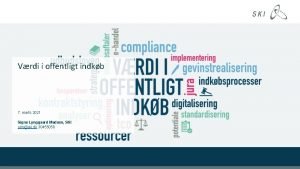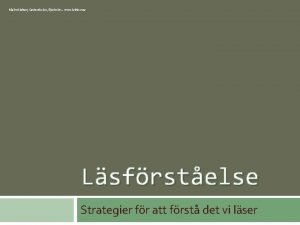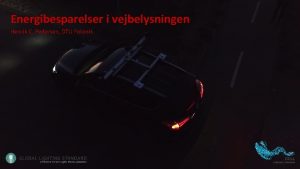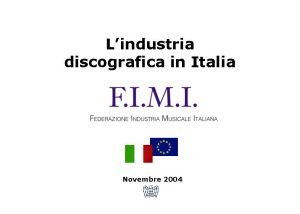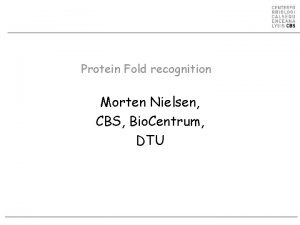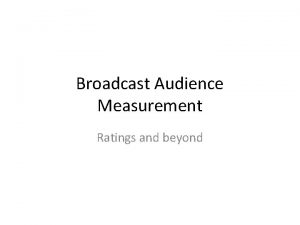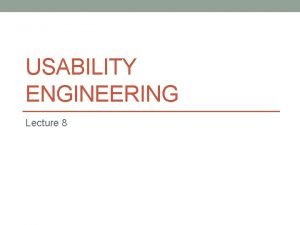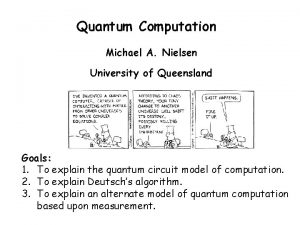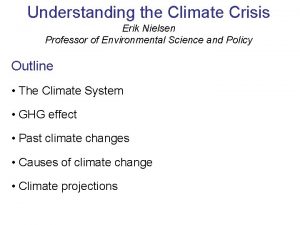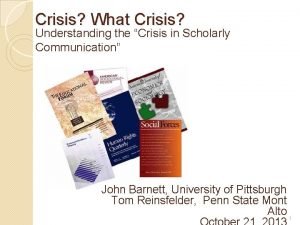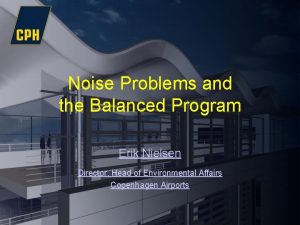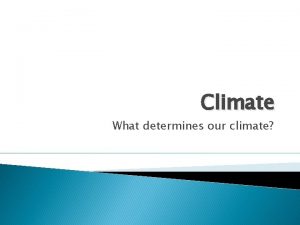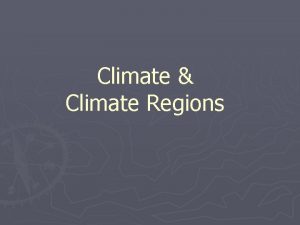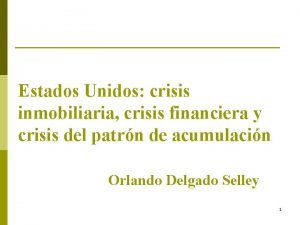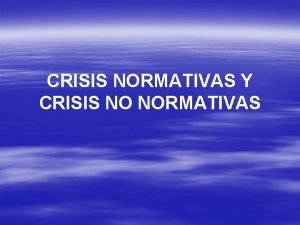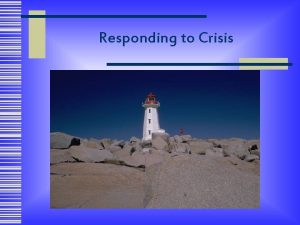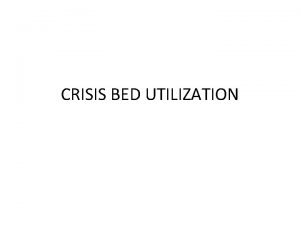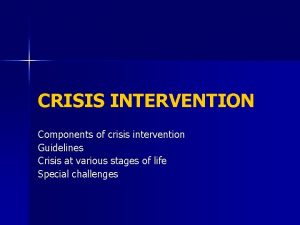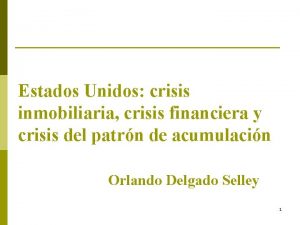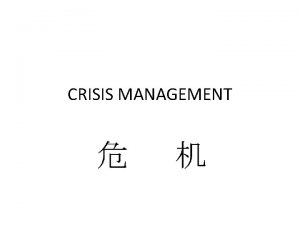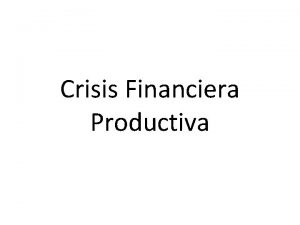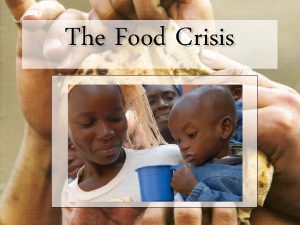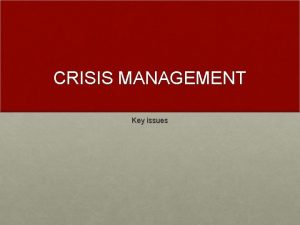Understanding the Climate Crisis Erik Nielsen Professor of


























- Slides: 26

Understanding the Climate Crisis Erik Nielsen Professor of Environmental Science and Policy Outline • The Climate System • GHG effect • Past climate changes • Causes of climate change • Climate projections

The Climate Crisis Take home message • Human influence on the climate system is clear • Unprecedented rate of warming is unequivocal • The time to act is now • Failure to act increases the risks of severe impacts on our environment and the global community • We have the tools but lack the political will and power

The climate system • Climate = long-term pattern of atmospheric conditions, including temperature, precipitation, and other variables • Earth’s climate system includes the atmosphere, ocean, land, ice, vegetation

Causes of climate change Volcanic eruptions Changes in atmospheric composition (greenhouse) • Climate change is driven by five causes (radiative forcings) • Internal components of the climate system respond by changing and interacting in many ways

GHG effect

• Greenhouse gases trap infrared (back) radiation from the Earth (1820) • This radiative forcing warms the earth • Human-induced green house effect adds an additional 2. 7 W/m 2 • Amount of warming caused by this forcing depends on the sensitivity of the climate system • The sensitivity of climate depends on the strength of feedbacks (oceans, land, ice, etc. ) which themselves are not constant ee for more detailed description of energy balance https: //earthobservatory. nasa. gov/features/Energy. Balance/page 6. php

IPCC, 2007 Radiative forcing attribution and certainty • Direct forcing by greenhouse gases has a high level of certainty • Effect of aerosols (include sea salt, dust, and volcanic ash, as well as soot, sulfates, and other particles produced by people burning fossil fuels. Natural and human-caused fires are also significant sources of aerosols) is less certain, partly because their effect on cloud formation is uncertain, as is the impacts of clouds themselves

Understanding Past Climate Changes Tree rings Stalagmites Corals PALEOCLIMATOLOGY Historical documents Ice Lake & marine sediments

Air bubbles trapped in the ice are the primary source of information on past atmospheric composition The longest, highest-resolution climate records come earth’s two surviving ice sheets: Greenland Antarctica

Human emissions CO 2 at its highest level in probably 20 million years (humans 200, 000 years ago) Source: NASA https: //climate. nasa. gov/evidence/

How do we know humans are driving climate change? • Models are tested by entering real data from the past and seeing how well the model would have predicted past trends • Models that incorporate only natural factors or only anthropogenic factors predict poorly • But models including both natural and anthropogenic factors predict very well IPCC, 2007

Models including human emissions predict land temperature, land ocean, and ocean temperature changes. IPCC, 2018

Current and Future Climate Crisis Dynamic visualization of the Relationship between CO 2 emissions, temperature and global carbon budget Source: http: //openclimatedata. net/climatespirals/from-emissions-to-global-warming/

Current Climate Crisis IPCC, 2016

Sea level • Global sea level has risen by about 17 cm over the last 100 years • At least 25%, probably more, was caused by volumetric expansion due to warming surface ocean water • The rest is from melting glacier ice and iceberg discharge • Absolute amount of sealevel rise is difficult to determine because it varies from place to place Sea-level rise during the 20 th century (cm) Ocean thermal expansion 4+ Mountain glaciers 5 Greenland & Antarctic ice 2 Total 11 Observed rise 17

The Future Challenge IPCC, 2018 dynamic of emissions and sinks and lagged effects on climate Source: https: //www. climateinteractive. org/

IPCC 2016

Addressing the Current Climate Crisis “limiting global warming to 1. 5 degrees Celsius would likely save the global economy more than $20 trillion by the year 2100 as compared to 2 degrees Celsius warming—at a cost of about $300 billion” Burke et al. 2018

Our challenge

Global Carbon Budget to keep warming below 1. 5 C The time to act is now: • 14 years at current levels of emissions for 50% chance of limiting warming • 10 years at current levels for 66% chance Source: IPCC 2018, Global Warming of 1. 5⁰C

What is the global, US and local decarbonization challenge? • Need to address all economic sectors of global economy • No one panacea solution • Options exist for each sector



US Energy Use and Transformation Source: https: //flowcharts. llnl. gov/ Rejected energy is wasted energy that does not do work or provide a service. Think the heat from a car engine/brakes or the heat from an incandescent lightbulb Quad: Quadrillion BTUs Global Energy consumption is approximately 510 Quads

AZ GHG emissions Source: WWW. AZCLIMATECHANGE. US

Sources: Climate Interactive: Great source from MIT on climate dynamics, policy and systems thinking https: //www. climateinteractive. org/ IPCC (2018) Understanding Climate Change of 1. 5 C⁰, https: //www. ipcc. ch/sr 15/chapter/spm/ IPCC (2016) AR 5 Climate Change Synthesis Report https: //www. ipcc. ch/report/ar 5/syr/ see summary for policymakers as the consensus of the scientific community on the science of climate change. Lawrence Livermore National Laboratory (2018) Carbon and Energy Flow charts https: //flowcharts. llnl. gov/ World Resources Institute: Good source on graphics on historic and current GHG emissions https: //www. climatewatchdata. org/ and https: //www. wri. org/blog/2017/08/6 -charts-understand-usstate-greenhouse-gas-emissions NASA: Climate Evidence https: //climate. nasa. gov/evidence/ Covers the basics of the science of climate change US EPA: Climate Change information https: //19 january 2017 snapshot. epa. gov/climatechange_. html This is an archived web page of the EPA since the current administration has removed much of the climate information from the current web site. US National Climate Assessment https: //nca 2014. globalchange. gov/ Assessment of climate impacts to regions of the US US Global Change Program: Interagency working group on Climate Change including the department of defense https: //globalchange. gov
 Promotion from assistant to associate professor
Promotion from assistant to associate professor Myasthenic vs cholinergic crisis
Myasthenic vs cholinergic crisis Climate change 2014 mitigation of climate change
Climate change 2014 mitigation of climate change 2015 nielsen global corporate sustainability report
2015 nielsen global corporate sustainability report Janni hadulla nielsen
Janni hadulla nielsen Holger-nielsen metodu ne için kullanılır
Holger-nielsen metodu ne için kullanılır Morten nielsen dtu
Morten nielsen dtu Nielsen data training
Nielsen data training Ligevægtssystem
Ligevægtssystem Amrld
Amrld Lektion.se
Lektion.se Cbs dtu
Cbs dtu Nielsen
Nielsen Cps nielsen
Cps nielsen Holger nielsen yöntemi
Holger nielsen yöntemi Henrik nielsen dtu
Henrik nielsen dtu Aree nielsen
Aree nielsen Morten nielsen dtu
Morten nielsen dtu Simon mørch
Simon mørch Bio centrum
Bio centrum Audimeter
Audimeter Lilli nielsen
Lilli nielsen Sygdomme i vårbyg
Sygdomme i vårbyg Usability engineering jakob nielsen
Usability engineering jakob nielsen Nielsen quantum computing
Nielsen quantum computing Helle lykke nielsen
Helle lykke nielsen Trine dyrstad pettersen
Trine dyrstad pettersen




